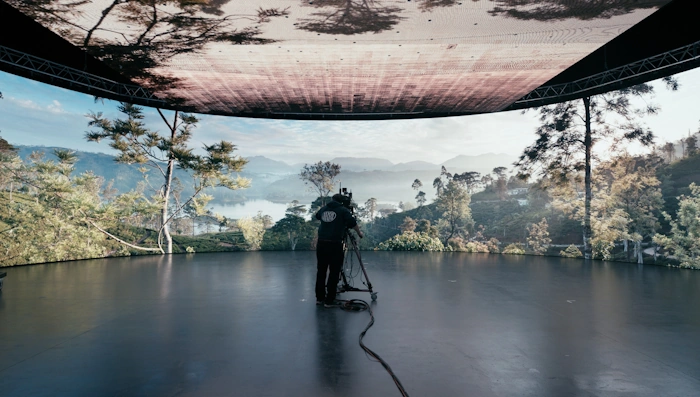ARRI, a name synonymous with cutting-edge film technology since 1917, might be on the brink of revolutionizing the industry once again. Known for its world-class cameras and lighting equipment, ARRI is now making a bold leap into virtual production—one that could mark the end of traditional green screens as we know them.
The magic is happening at ARRI’s newly launched virtual production stage in London. But this isn’t just any film set. The stage features a massive 30-meter by 5-meter LED screen capable of displaying 16K resolution, creating a photorealistic backdrop that can transport filmmakers anywhere in an instant. One moment, you’re shooting in a lush forest; the next, you’re in the middle of a desert—no planes, trains, or elaborate set changes required.
What makes this stage truly revolutionary is how it eliminates the need for green screens while offering an immersive experience for actors and directors. Unlike traditional setups, where actors must imagine their surroundings, this LED environment allows them to interact naturally with realistic backdrops. The lighting is another game-changer—since the LED screens provide accurate environmental lighting, there’s no need to artificially match it in post-production. Everything happens in real time, giving directors the flexibility to adjust locations, weather conditions, or even time of day instantly. A single set can now host sunrise, sunset, and night scenes all in one shoot.
ARRI didn’t achieve this breakthrough alone. They partnered with Creative Technology, a leader in live event production, to bring the concept to life. The collaboration resulted in a fully integrated system that includes motion tracking technology, such as Viacom, enabling real-time camera movements within a 3D space. AI-driven Unreal Engine adds another layer of magic by dynamically generating photorealistic environments and adjusting lighting on the fly, ensuring seamless interaction between the camera and virtual surroundings.
Beyond its filmmaking advantages, virtual production also carries significant environmental benefits. By reducing the need for physical sets and long-distance travel, it drastically lowers the carbon footprint of film production. Plus, with digital assets replacing costly physical builds, post-production time and energy consumption in data centers are significantly reduced—saving both money and resources.
The potential for ARRI’s virtual production stage to transform the film industry is immense. It’s already proving popular for everything from TV shows to commercials and is particularly effective for scenes involving cars or moving environments. Gone are the days of filming in a car mounted on a trailer—now, everything happens in a controlled, virtual space.
But the impact of this technology extends far beyond filmmaking. While ARRI’s primary focus remains on film and TV production, similar LED volume setups are being explored for live events and concerts, enabling immersive, ever-changing backgrounds without costly stage redesigns. Corporate presentations and virtual conferences could benefit from hyper-realistic digital environments, making online meetings more engaging. The education sector is another frontier, where virtual classrooms could allow students to explore historical sites or scientific concepts in real time.
Looking ahead, the possibilities expand even further. Medical training simulations could use this technology for highly detailed, interactive surgical practice. The metaverse and VR industries may integrate ARRI’s LED volume tech to create hyper-realistic digital worlds for social interaction, gaming, and remote work. Even NASA and private space agencies could leverage this advancement to simulate deep-space environments for astronaut training.
With all the possibilities ARRI’s new stage opens up, it’s clear the film industry is on the verge of a major transformation. But this is just the beginning, virtual production isn’t a passing trend; it’s here to stay. From advertising to space exploration, this technology is poised to reshape how we create, learn, and experience digital worlds, potentially bringing the green screen era to a close for good.
Discover more from TECH HOTSPOT
Subscribe to get the latest posts sent to your email.
